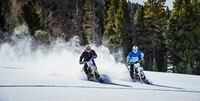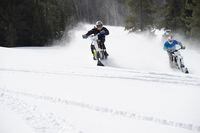Winter is still in full force, and that means that it’s not hard to find reasons to get out and play in the snow. Sure, snowmobiles are fun, but what we (and all other off-roaders) really get excited about is snowbikes—you know, converted two-wheeled machines that have a track on the back, a ski on the front, and a smiling rider behind the handlebar. Recently, Polaris—parent company of Timbersled—invited us up to Northern Utah to give the new 2017 Timbersled models a go. The powder was fresh, the weather was cold, and the converted Husqvarnas were running great. Here’s a quick recap and an inside look at what went down:
/cloudfront-us-east-1.images.arcpublishing.com/octane/TVMEUXP7XLXRRXKAPJVZCLS5FU.jpg)
2016 Timbersled
/cloudfront-us-east-1.images.arcpublishing.com/octane/2S3563QUWS5TZK55SKCGUTC5SE.jpg)
2016 Timbersled

2016 Timbersled
/cloudfront-us-east-1.images.arcpublishing.com/octane/XZ3VONOTGPDSK7OZERTY32AHVQ.jpg)
2016 Timbersled

2016 Timbersled
/cloudfront-us-east-1.images.arcpublishing.com/octane/3SZ7AEZK52MHLRFGDMU4LSMSZY.jpg)
2016 Timbersled
/cloudfront-us-east-1.images.arcpublishing.com/octane/3THDNKHSLS63OPVFBYCGQ7ZB7I.jpg)
2016 Timbersled
/cloudfront-us-east-1.images.arcpublishing.com/octane/JTO2HWLHNKKKF4KIVQ2IA27PIE.jpg)
2016 Timbersled
/cloudfront-us-east-1.images.arcpublishing.com/octane/PGVUG6DIGOFVOU5NT7PQYHC5ZA.jpg)
/cloudfront-us-east-1.images.arcpublishing.com/octane/MMAOLEHZG5CBXAOICNKNGCEK4I.jpg)
/cloudfront-us-east-1.images.arcpublishing.com/octane/KQUVDTNB6VF53CRDNN47BE3VUA.jpg)
/cloudfront-us-east-1.images.arcpublishing.com/octane/3T32INAZQRGPXOGGA36NQJDSSM.jpg)
/cloudfront-us-east-1.images.arcpublishing.com/octane/EPLS5PBKXBHNXK7S5O7G4ND3YQ.jpg)
/cloudfront-us-east-1.images.arcpublishing.com/octane/MNGOZAGZFZBH5DPFV7NOPF5S3Y.jpg)
/cloudfront-us-east-1.images.arcpublishing.com/octane/VGJWIIFM2VBCXG34KRQ37GCP7U.jpg)
/cloudfront-us-east-1.images.arcpublishing.com/octane/2ZU3HXRPMZESJF7HDLZJV7FHEY.jpg)
/cloudfront-us-east-1.images.arcpublishing.com/octane/VVFWQBZEIZDVJHZIW5ISKWKOZU.jpg)
/cloudfront-us-east-1.images.arcpublishing.com/octane/7T7FZXHIIBDX7AOBD5S3IICUJI.jpg)
/cloudfront-us-east-1.images.arcpublishing.com/octane/T3Y7A52TXBEBJNEPGOQSVPQSPU.jpg)
/cloudfront-us-east-1.images.arcpublishing.com/octane/KY33U3WBTNFIBJFMTEF2SM7BOQ.jpg)
/cloudfront-us-east-1.images.arcpublishing.com/octane/JNPS5MGVXJC7BARVMARYQIQHXE.jpg)
/cloudfront-us-east-1.images.arcpublishing.com/octane/63N2P6SYAZDURJDO5KARQYX2J4.jpg)
/cloudfront-us-east-1.images.arcpublishing.com/octane/C72WX35SXFETTO5OVA2RWT523I.jpg)
/cloudfront-us-east-1.images.arcpublishing.com/octane/F3ER37EV2RGY5CRYFNTWE3JSF4.jpg)
/cloudfront-us-east-1.images.arcpublishing.com/octane/L65QCUR32RH2NKCUHXYHHAPDFI.jpg)
/cloudfront-us-east-1.images.arcpublishing.com/octane/VSK246VVRRDMBNQU7B2NTNY6AE.jpg)
/cloudfront-us-east-1.images.arcpublishing.com/octane/CG64RRFAYRENNAP2AA22T2LSJY.jpg)
/cloudfront-us-east-1.images.arcpublishing.com/octane/IKZSRLBWMRDORMORBXSISL4D6M.jpg)
/cloudfront-us-east-1.images.arcpublishing.com/octane/BJLVRPJSDFC3ZLPMW3LYYHMPZE.jpg)
/cloudfront-us-east-1.images.arcpublishing.com/octane/RQW2RFU4MJDYRPVFJNW362SEXU.jpg)
/cloudfront-us-east-1.images.arcpublishing.com/octane/CGQDU7HEEBBWBLF6SMXCJIW7DI.jpg)
/cloudfront-us-east-1.images.arcpublishing.com/octane/B35XXACE4ZGU5BWSEMEFUL6SN4.jpg)
/cloudfront-us-east-1.images.arcpublishing.com/octane/TDSGY4VSSRC4LP6PYXP62U236Y.jpg)